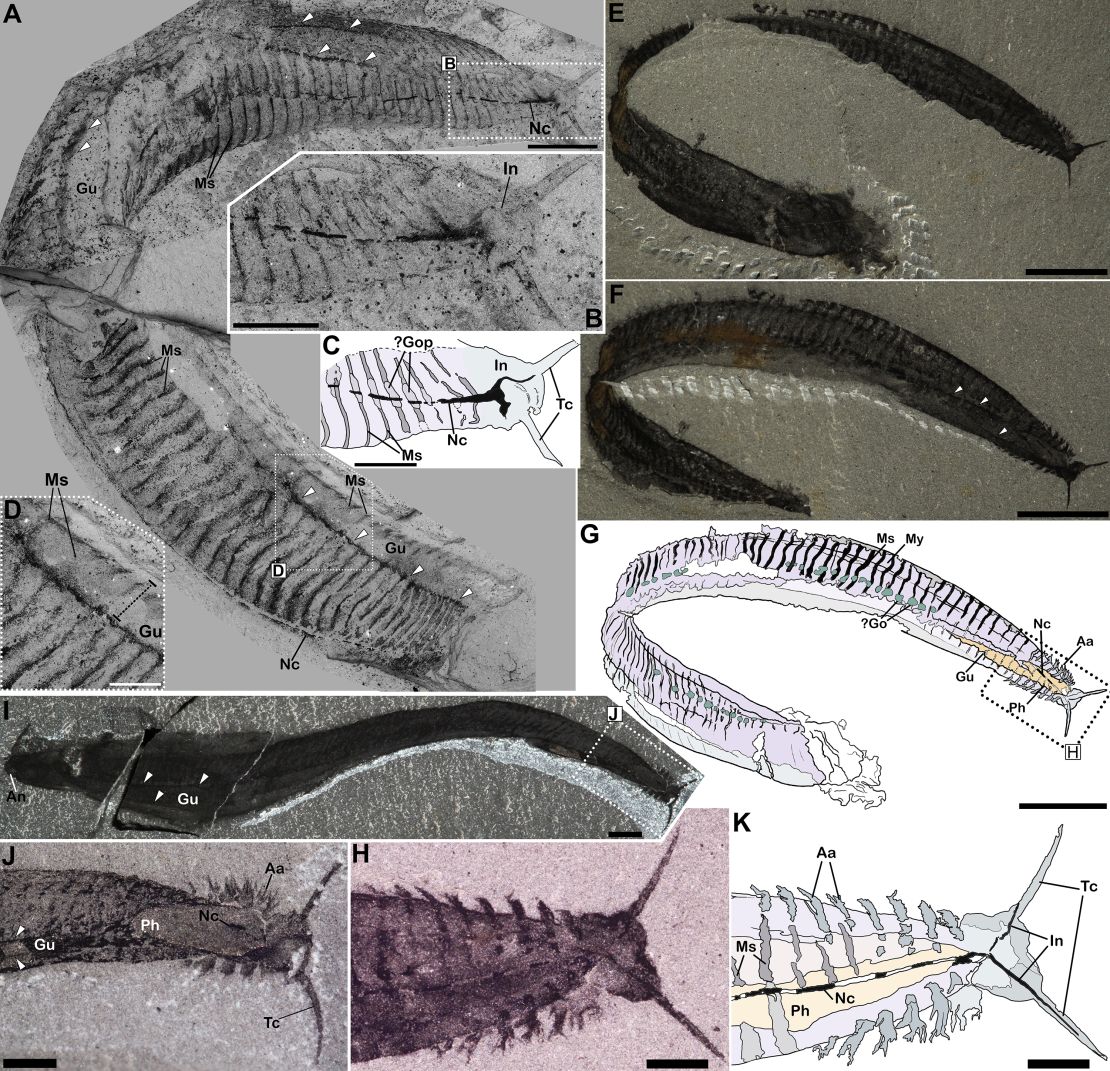Sign up for CNN’s Science of Miracles newsletter. Explore the universe with news of fascinating discoveries, scientific advances and more.
CNN
–
An extinct ribbon-shaped sea creature about the size of a human hand was one of the earliest animals to evolve a precursor to a backbone. Scientists recently identified the animal’s nerve cord using a hard curve. They turned her fossils upside down.
Paleontologist Charles Doolittle Wolcott first encountered Pikaia fossils in the Burgess Shale deposits of British Columbia, dating back 508 million years, and described them in a 1911 treatise. The animal was approximately 6.3 inches (16 centimeters) long and had a flattened, twisted body and a small head, covered with two tentacles and fringed with external gills. These were originally thought to be rudimentary legs, so the animal was positioned with these structures facing downwards.
In 2012, after decades of studying Pikaia fossils, researchers described its fossilized internal structures in detail. They identified a long strand near the abdomen as a blood vessel and named a 3D sausage-shaped structure running down the animal’s back as a dorsal organ, possibly used for internal support, although such an organ did not anatomically resemble anything seen in fossils or in life. animals.
However, the latest analysis of Pikaia fossils by another team of scientists, published on June 11 in the journal Current Biology, has overturned this view and all other previous studies about Pikaia.
According to the researchers, previous anatomical interpretations positioned the animal wrong side up. The so-called dorsal organ was actually located in the abdomen and was the intestine of Pikaia. The supposed blood vessel was a nerve cord, a feature associated with the group of animals known as chordates, in the group Chordata.

All chordates, such as vertebrates, eel-like lancelets and tunicates, or sea squirts, at some point in their lives have a flexible rod-shaped nerve structure called a notochord on their back.
Pikaia was originally thought to be a worm, then upgraded to an early type of chordate, based on features such as the shape of certain muscles and the position of its anus. But experts were unsure where exactly Pikaia belonged in the chordate family tree.
With the description of a nerve cord, Pikaia can now be considered part of the basic lineage of all chordates, even though it has no direct descendants that are alive today, the study authors reported.
The Pikaia reversal “clears things up a lot,” said evolutionary biologist Dr. Jon Mallatt, a clinical professor at the University of Idaho. Mallatt, who was not involved in the new research, published a paper on Pikaia in 2013, working from the upright (and upside down) body position.
In retrospect, the truth was “hiding in plain sight,” and the change in orientation resolves questions about why the supposed blood vessel and dorsal structure of Pikaia clashed with established anatomical features in other chordates, Mallatt said.
“Pikaia has suddenly become a lot less weird,” he said.
The reassessment of which way was up for Pikaia began years ago with a co-author of the new study, Dr. Jakob Vinther, a lecturer in macroevolution at the University of Bristol in the UK, said lead study author Giovanni Mussini, a researcher and PhD candidate in the Department of Earth Sciences at the University of Cambridge in the UK.
There were a number of reasons for revising previous interpretations of the fossils, Mussini told CNN. First, there was the puzzle of what scientists had believed to be the position of the dorsal organ. Its placement – close to what was supposed to be the Pikaia’s back – apparently ruled out the possibility that the organ was an intestine.
However, once Pikaia was turned upside down, the location and features of the organ made more sense anatomically. It expanded and extended into the animal’s pharynx, the region of the throat where a gut usually connects to a mouth. Its 3D status can be explained by the presence of chemically reactive tissues – hallmarks of a gut. In other Burgess Shale fossils, the abundant ions and reactive compounds commonly found in gut tissue cause the digestive structures to mineralize faster than the rest of the body, thereby retaining more of their original shapes. The structures inside Pikaia’s organ were probably the remains of ingested food, according to the study.

In an inverted Pikaia, the outer gills that previously pointed downward were now curved upwards, as are the outer gills in modern mudskippers and axolotls.
Flipping Pikaia also changed the orientation of muscle groups that bunch together in a wave formation. These muscles, called myomeres, are a key feature in vertebrates. In the new position of Pikaia, the strongest point of flexion of these muscles is along the back, which is also true of the arrangement of the myomeres in other animals with backbones.
“This makes the Pikaia movement consistent with what we see in modern chords,” Mussini said.
The putative blood vessel of Pikaia was also anatomically odd, as it lacked the branches normally found in vertebrate blood vessels.
“It’s a single line that goes through most of the body to the head, where it bifurcates into those two strands in the tentacles,” Mussini said.

An important part of recognizing the structure as a nerve cord was the fossilized nervous systems in other animals from the Cambrian Period (541 million to 485.4 million years ago) that were discovered over the past decade, Mussini added.
“We have a better understanding of how nerve cords and other tissues fossilize because we’ve been fortunate enough to find quite a few Cambrian nervous systems preserved in other deposits,” he said, “mainly from Chinese fossils that came to light in the last. several years.”
Many of these fossils were arthropods—invertebrates with exoskeletons—with living relatives such as insects, arachnids, and crustaceans; Comparing fossils with modern arthropods helped paleontologists identify preserved internal tissues. One example is a fossil specimen of the Cambrian arthropod Mollisonia, which showed brain organization comparable to that of living spiders, scorpions and crabs, Mussini said.
While there are no living analogues for Pikaia, the arthropod fossil record gave scientists a more detailed frame of reference for Pikaia’s nerve cord. Like other fossilized nerve tissue, the nerve cord in Pikaia was dark, carbon-rich, and relatively fragile compared to other fossilized tissue.
That nerve cord solidifies Pikaia’s status as a chordate, placing it “very much at the base of what we would consider traditional chordates,” Mallatt said.
Much about Pikaia’s anatomy remains a mystery, but looking at it from a new angle could provide new insights into its strange array of features, Mussini said.
“Many of these details have only come to light in the last 10 or 12 years,” added Mussini. “The authors of the 2012 paper can certainly be forgiven for not bringing these details into the conversation because it is a work in progress.”
Mindy Weisberger is a science writer and media producer whose work has appeared in Live Science magazine, Scientific American, and How It Works.




Leave a Reply